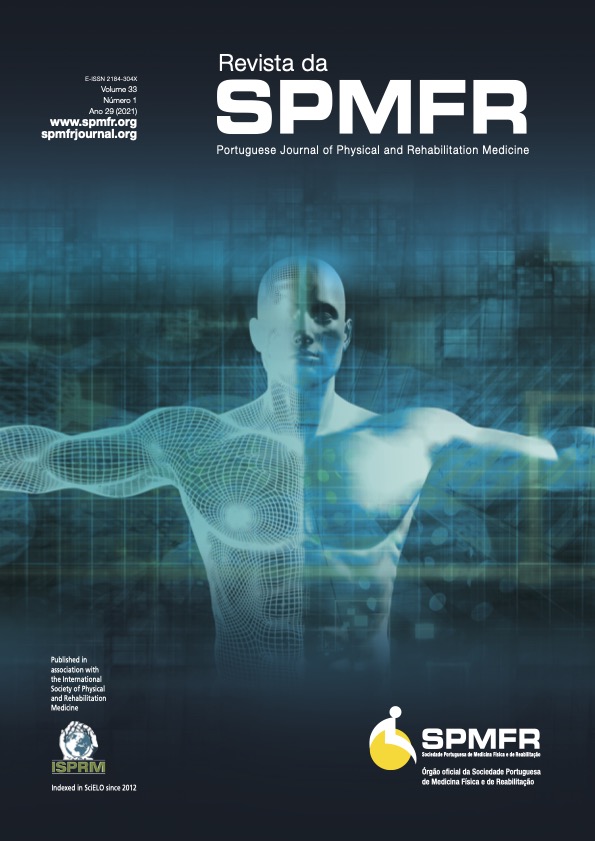Unidade de Desmame Ventilatório: Porquê?
DOI:
https://doi.org/10.25759/spmfr.434Resumo
.Downloads
Referências
Esquinas AM. Noninvasive Mechanical Ventilation and Difficult Weaning in Critical Care. Berlin: Springer; 2016.
Lone NI, Walsh TS. Prolonged mechanical ventilation in critically ill patients: epidemiology, outcomes and modelling the potential cost consequences of establishing a regional weaning unit. Crit Care. 2011;15:R102. doi: 10.1186/cc10117.
Damuth E, Mitchell JA, Bartock JL, Roberts BW, Trzeciak S. Long-term survival of critically ill patients treated with prolonged mechanical ventilation: a systematic review and meta-analysis. Lancet Respir Med. 2015;3:544-53. doi: 10.1016/S2213-2600(15)00150-2.
Kahn JM. The evolving role of dedicated weaning facilities in critical care. Intensive Care Med. 2010;36:8-10. doi: 10.1007/s00134-009-1672-4.
Hill AD, Fowler RA, Burns KE, Rose L, Pinto RL, Scales DC. Long-Term Outcomes and Health Care Utilization after Prolonged Mechanical Ventilation. Ann Am Thorac Soc. 2017;14:355-62. doi: 10.1513/AnnalsATS.201610-792OC.
Martinez GH, Fernandez R, Casado MS, Cuena R, Lopez-Reina P, Zamora S, et al. Tracheostomy tube in place at intensive care unit discharge is associated with increased ward mortality. Respir Care. 2009;54:1644-52.
Zilberberg MD, Shorr AF. Prolonged acute mechanical ventilation and hospital bed utilization in 2020 in the United States: implications for budgets, plant and personnel planning. BMC Health Serv Res. 2008;8:242. doi: 10.1186/1472-6963-8-242.
Pereira F, Silva AM, Vaz IM, Viamonte S, Winck JC. Tracheostomy prevalence at Skilled Nursing Facilities. Pulmonology. 2020;26:90-4. doi: 10.1016/j.pulmoe.2019.05.011.
Navalesi P, Frigerio P, Patzlaff A, Häußermann S, Henseke P, Kubitschek M. Prolonged weaning: from the intensive care unit to home. Rev Port Pneumol. 2014;20:264-72. doi: 10.1016/j.rppneu.2014.04.006.
Ambrosino N, Vitacca M. The patient needing prolonged mechanical ventilation: a narrative review. Multidiscip Respir Med. 2018;13:6. doi: 10.1186/s40248-018-0118-7.
Herridge MS, Moss M, Hough CL, Hopkins RO, Rice TW, Bienvenu OJ, et al. Recovery and outcomes after the acute respiratory distress syndrome (ARDS) in patients and their family caregivers. Intensive Care Med. 2016;42:725-38. doi: 10.1007/s00134-016-4321-8.
Carpenè N, Vagheggini G, Panait E, Gabbrielli L, Ambrosino N. A proposal of a new model for long-term weaning: respiratory intensive care unit and weaning center. Respir Med. 2010;104:1505-11. doi: 10.1016/j.rmed.2010.05.012.
Subbe CP, Criner GJ, Baudouin SV. Weaning units: lessons from North America? Anaesthesia. 2007;62:374-80. doi: 10.1111/j.1365-2044.2007.04984.x.
Gracey DR, Hardy DC, Koenig GE. The chronic ventilator-dependent unit: a lower-cost alternative to intensive care. Mayo Clin Proc. 2000;75:445-9. doi: 10.4065/75.5.445.
Hannan LM, Tan S, Hopkinson K, Marchingo E, Rautela L, Detering K, et al. Inpatient and long-term outcomes of individuals admitted for weaning from mechanical ventilation at a specialized ventilation weaning unit. Respirology. 2013;18:154-60. doi: 10.1111/j.1440-1843.2012.02266.x.
Mifsud Bonnici D, Sanctuary T, Warren A, Murphy PB, Steier J, Marino P, et al. Prospective observational cohort study of patients with weaning failure admitted to a specialist weaning, rehabilitation and home mechanical ventilation centre. BMJ Open. 2016;6:e010025. doi: 10.1136/bmjopen-2015-010025.
Davies MG, Quinnell TG, Oscroft NS, Clutterbuck SP, Shneerson JM, Smith IE. Hospital outcomes and long-term survival after referral to a specialized weaning unit. Br J Anaesth. 2017;118:563-9. doi: 10.1093/bja/aex031.
Pilcher DV, Bailey MJ, Treacher DF, Hamid S, Williams AJ, Davidson AC. Outcomes, cost and long term survival of patients referred to a regional weaning centre. Thorax. 2005;60:187-92. doi: 10.1136/thx.2004.026500.
Downloads
Como Citar
Edição
Secção
Licença
Os manuscritos devem ser acompanhados de declaração de originalidade, Autoria e de cedência dos direitos de propriedade do artigo, assinada por todos os Autores.
Quando o artigo é aceite para publicação é obrigatória a submissão de um documento digitalizado, assinado por todos os Autores, com a partilha dos direitos de Autor entre Autores e a Revista SPMFR, conforme minuta:
Declaração Copyright
Ao Editor-chefe da Revista da Sociedade Portuguesa de Medicina Física e Reabilitação
O(s) Autor(es) certifica(m) que o manuscrito intitulado:
____________________________________________________________________ (ref.Revista da SPMFR_________) é original, que todas as afirmações apresentadas como factos são baseados na investigação do(s) Autor(es), que o manuscrito, quer em parte quer no todo, não infringe nenhum copyright e não viola nenhum direito da privacidade, que não foi publicado em parte ou no todo e que não foi submetido para publicação, no todo ou em parte, noutra revista, e que os Autores têm o direito ao copyright.
Todos os Autores declaram ainda que participaram no trabalho, se responsabilizam por ele e que não existe, da parte de qualquer dos Autores conflito de interesses nas afirmações proferidas no trabalho.
Os Autores, ao submeterem o trabalho para publicação, partilham com a Revista da SPMFR todos os direitos a interesses do copyright do artigo.
Todos os Autores devem assinar
Data:
Nome(maiúsculas)
Assinatura
Relativamente à utilização por terceiros a Revista da SPMFR rege-se pelos termos da licença Creative Commons “Atribuição – uso Não-Comercial – Proibição de Realização de Obras derivadas (by-nc-nd)”.
Após publicação na Revista SPMFR, os Autores ficam autorizados a disponibilizar os seus artigos em repositórios das suas instituições de origem, desde que mencionem sempre onde foram publicados.
OS AUTORES DEVERÃO SUBMETER UMA DECLARAÇÃO DE CONTRIBUIÇÃO / CONTRIBUTORSHIP STATEMENT INDICANDO O TIPO DE PARTICIPAÇÃO DE CADA AUTOR NO ARTIGO. Mais informações: https://authors.bmj.com/policies/bmj-policy-on-authorship/



